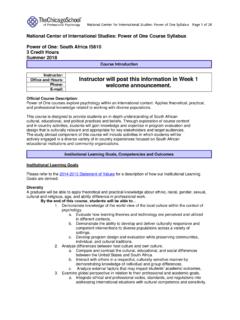Transcription of Tablets for Learning - PDST-Technology in Education
1 Tablets for Learning PDST Technology in Education , Jan 2017 1 Tablets for Learning Learning Context The increasing availability, adoption and use of Tablets in many aspects of life outside school demands that we reflect on whether they can be purposefully used for Learning in schools. The only reason to use ICT such as Tablets in schools is to support, enhance and transform the Learning experience in order to improve Learning outcomes for students. Though schools have much in common, in terms of Learning objectives, each school is different in terms of its own unique blend of requirements, priorities, and challenges. When considering new technologies such as introducing Tablets , school management and the ICT coordinating team should first consider school Learning priorities and Learning outcomes rather than just the technology aspects. As part of school self-evaluation process, identify overall school Learning priorities and outcomes School e- Learning plans should form an integral part of wider school planning Consider how ICT could help achieve these outcomes, and if Tablets could support Learning outcomes Attributes of Tablets to support Learning Tablets have different capabilities than other mobile computing devices such as laptops or netbooks: Tablets are light-weight, portable, touchscreen, are instant on with long battery life & use apps Like laptops and netbooks, Tablets are multi-functional mobile devices and can support student centred Learning .
2 The instant-on capability means that Tablets can be used without any start-up delays in a variety of situations, and this facilitates their use into areas where ICT might not have been considered before. It also facilitates use for a number of shorter periods (eg., 10 minutes) during class. Laptops and netbooks take longer to start-up, and this fact alone is an inhibitor to their use for short periods. The instant-on feature enables the possibility of 'anytime, anywhere' elearning within school, in outdoor Learning situations, or while on the move. As students already live in the world of instant-on & touch technologies such as mobile phones, they perceive this as the norm, and this raises similar expectations for ICT use in schools, which Tablets can support. Tablets for Learning PDST Technology in Education , Jan 2017 2 Tablets generally have longer battery life (typically over 8 hours) than laptops or netbooks, and this additional capability over laptops makes them usable throughout an extended school day.
3 Tablets seem to require less technical support than conventional desktops or laptops, and as such are being used increasingly in school situations where students bring their own devices (BYOD). This model also lends itself to students supporting their own devices. This is referred to as bring your own support (BYOS). If Tablets can support differentiated Learning while significantly reducing the level of technical support required, this model could greatly benefits schools. Suitable educational Tablets have high quality, high resolution screens and as such are suitable for literacy and numeracy related activities. They can be readily used by two or more students working collaboratively (ie., pair work). As touch screen technology has improved in recent years, Tablets have innovatively used these improvements to provide the user with a higher quality of user touch screen interactivity, including multi-touch pinch, zoom, rotate etc., For more refer to: Tablets are multi-functional devices and generally have integrated tools such as audio recording, front and rear cameras for photos and two-way video links.
4 Tablet capability is extended by the wide range of applications or 'apps' available. Tablets also support web browsing and online activities. Tablets use screen auto-rotate , ie., the screen re-orients itself as the device orientation changes, thus providing an improved user experience. Typing on a tablet is achieved using the soft keyboard (ie., on the screen), however external keyboard can be purchased for most devices, though at additional cost. Being wireless devices, Tablets generally don't have the same level of physical connections as laptops, though some have mini-USB ports, or expansion memory slots. Tablets generally have less memory storage than laptops. As such tablet users may use online or cloud based services, such as dropbox for storage or collaboration. Tablets are continuing to evolve to incorporate new and innovative capabilities to support Learning . For example in April 2014 applications such as Microsoft Office (ie., Word, Excel and Powerpoint) were made available for the first time as apps for certain Tablets , including the iPad.
5 Educational Considerations Educational possibilities for enhanced Learning with Tablets clearly exist, and there is a growing view that, guided effectively by teachers, they offer the potential for a new and exciting era in Education . Tablets offer new capabilities and opportunities for Learning , mainly in terms of their flexibility, mobile capabilities, and ease of use. This model can provide students with a shared or individual multi-functional Learning device in their own hands . This has the potential to support student centered, independent, differentiated and personalised Learning . In a classroom setting Tablets have the potential to support differentiated Learning , where each student can engage with Learning activities at their own pace, using their own personal approach in a way that allows the whole class to be engaged in common activities, but where each student is engaging at their own pace. Where Tablets are used by students, they may be used in a variety of ways.
6 Students could work collaboratively in small groups sharing one or more Tablets , or they may have access to their own device. Tablets for Learning PDST Technology in Education , Jan 2017 3 Where students have access to computing devices in school the balance of 'learner control' shifts from the teacher to the student. This in turn can facilitate and support student self-directed, active Learning and can facilitate higher levels of motivation and engagement in students. Students adapt quickly to new technologies and Tablets are seen as attractive Learning tools by students and have the potential to introduce more engagement and fun into Learning . Students increasingly have access to Tablets and smartphones outside of school, and so can adapt easily to their use in school. Tablets may not support certain applications which currently require a laptop or desktop computer, such as a specialised CAD software package. Though some laptops may have higher technical specifications, the combination of Tablets with a wide range of apps for Learning are attractive for schools.
7 Also many apps are free or low cost, and are easy to install. Good Practice Videos of using Tablets in schools The three videos highlighted here from the PDST Technology in Education website highlight relevant educational use of Tablets in schools: (Click on the link to access the video) 1. Using Tablet Devices in a Primary School: This video shows how Tablets are being used to develop active Learning especially for literacy and numeracy. It demonstrates the use of Tablets as a station activity with children engaged in active Learning methods. #64065663 2. Story Writing Using Tablets : This video shows a story builder app being used on Tablets and emphasises the process of story development. The children demonstrate that a variety of media can be incorporated into their stories. The mutual Learning that took place is a particularly salient point. #64069464 3. ICT in the MFL Classroom: This video demonstrates using a tablet to support oral language development in Spanish.
8 Tablets for Learning PDST Technology in Education , Jan 2017 4 #42829461 Students bringing their own devices/ Tablets /technologies: (BYOD/T) BYOD is worth consideration in terms of allowing students to bring in their own devices. The following video shows a clip of a post-primary principal talking about how BYOD is used in her school. Software and Tablets Differences/advantages: Tablets use specific 'apps' instead of more traditional software applications. There are increasing numbers of software 'apps' for Education , including many for literacy, numeracy and other subject areas. There are also specialist apps available for different areas, such as science, and special educational needs (SEN) areas. Apps are generally available online via the Apple, Google or Microsoft online app-stores . Many educational apps are free, or have a free basic version, while more featured versions are generally available at no more than a few euros. Apps are easy to install.
9 There are many apps which can support students with special educational needs (SEN), including Dyslexia and ASD. Refer to links below. Some well-known document editing, spreadsheet and presentation software (such as Microsoft Office) have recently been made available on Tablets . These types of developments may make Tablets even more attractive than heretofore. Software differences/limitations: Tablets generally allow use of just one 'app' at any one time, whereas laptops can have a number of local applications running simultaneously. Tablet data or document formats may differ from PC or 'Apple Mac' type formats. Schools that wish to have ebooks on a variety of different devices need to check that their selected ebook publisher supports their range of devices. Tablets can t be connected (by LAN cable) to a fixed network as they are wireless only devices Tablets for Learning PDST Technology in Education , Jan 2017 5 Purchasing Considerations Before a school purchases Tablets , it would be important that the school is confident that the chosen tablet is the 'right Learning choice' for the school.
10 Seeking advice from a similar type of school that is already successfully using Tablets to enhance Learning is an excellent way of getting relevant up to date contextual information and feedback. This could also be achieved by some teachers evaluating Tablets in different Learning situations or subject areas, discussing with colleagues and with other schools, in the wider context of elearning planning. Following this evaluation the school should have a more realistic expectation of the tablet capability and be in a better situation to make a decision. The most popular tablet currently being used in Education in Ireland is the iPad. Android (developed by Google) based Tablets are also available from a number of providers. Microsoft introduced its Surface tablet. The Surface is the version used in Education , while the Surface Pro 3 and 4 have a higher technical specification and are more expensive. If a school places a priority on students having access to mobile Learning devices in class, then it comes down to a choice between laptops/ netbooks on one hand or Tablets on the other.



